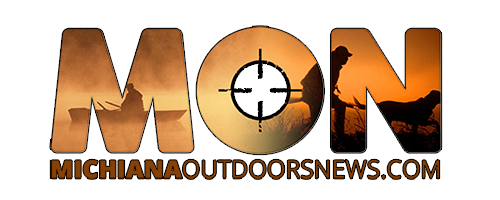- Details
By Louie Stout
If you fish Oliver chain of lakes for trout, the Indiana DNR wants to hear from you this season.
The Chain consists of about 517 acres and includes Oliver, Martin and Olin lakes in LaGrange County.
Plans call for a comment box to be placed at the public access. A survey card will be there as well and anglers are encouraged to fill out the brief survey and deposit it in the box. In addition, a camera will be positioned on the boat ramp so officials can assess public use of the lake.
Historically, fisheries biologists place a part-time creel clerk at state accesses to query anglers as they come off the water.
“Posting a creel clerk on the lake can be expensive, so we’re trying this to see if it works,” says District Fisheries Biologist Matt Horsley. “Western states and some southern Indiana lakes have had success with it.”
- Details
IDNR Report
The Indiana DNR continues to detect highly pathogenic avian influenza (HPAI) in wild birds throughout Indiana and has currently detected the H5NI virus in 30 counties. HPAI is also suspected in an additional 32 counties based on reports involving the deaths of raptors, cranes, and waterfowl.
Counties where avian influenza has been detected in wild birds currently are Adams, Allen, Bartholomew, Benton, Boone, Clinton, Decatur, Gibson, Greene, Hamilton, Hancock, Hendricks, Henry, Huntington, Jackson, Jasper, Lake, LaPorte, Marion, Newton, Pike, Porter, Randolph, Ripley, Shelby, Starke, Tippecanoe, Union, Vanderburgh, and Vermillion.
HPAI is a disease caused by an influenza virus that usually spreads among birds. It is common in wild birds, especially waterfowl, shorebirds, and raptors. Notably, more than 1,500 sandhill cranes have been affected by the virus since January, resulting in a large number of sandhill crane deaths in Greene, Jackson, Jasper, LaPorte, Newton, Starke, and Union counties.
If you find sick or dead wild birds, please report them at on.in.gov/sick wildlife.
According to the Centers for Disease Control and Prevention (CDC), the public health risk for HPAI is low. However, it is possible for humans to contract HPAI. People who have close contact with infected animals or their environments, such as poultry farm workers or wildlife rehabilitators, are at higher risk.
Members of the public should avoid contact with sick waterfowl and other sick wildlife whenever possible. However, if it is necessary to remove a carcass, safely dispose of it by wearing a mask and disposable gloves to double bag any carcasses and place them in a secure trash container. Wash hands immediately after with soap and warm water. Alternatively, a wildlife control operator can be hired to remove carcasses.
A list of wildlife control operators can be found here. DNR does not offer carcass removal services.
DNR continues to monitor avian influenza in affected species throughout the state.
- Details
TIP Report
Hoosiers are reminded that when they see, hear or learn about someone illegally stealing wildlife, known as poaching, there’s an easy way to alert authorities – the Turn in a Poacher (TIP) program.
DNR manages wildlife for everyone, and every person can help TIP support DNR efforts by reporting potential violations at 1-800-TIP-IDNR (800-847-4367) or tip.IN.gov. Doing so will help conserve wildlife for future generations.
If your “TIP” leads to an arrest, you may receive as much as a $500 reward, or you can remain anonymous if you choose. In 2024, TIP received nearly 1,025 tips and paid thousands of dollars in rewards for tips that led to the arrest of a suspect.
To support Indiana’s TIP program, Indiana Conservation Officers have added a new poaching awareness display trailer that helps highlight how poaching affects Indiana’s natural resources while advertising the TIP program. The trailer features evidence related to actual Indiana wildlife cases, allowing visitors to learn details of the cases.
The trailer was purchased under the direction of the International Wildlife Crimestoppers and in a partnership effort between the DNR Division of Law Enforcement and the Indiana Chapter of the National Wild Turkey Federation, and the trailer’s wrap was provided by the TIP program.
TIP is a nonprofit conservation organization that partners with DNR to protect fish and wildlife resources by increasing public support and involvement in bringing violators to justice.
- Details
IDNR Report
The Indiana DNR has confirmed Indiana’s second positive case of chronic wasting disease (CWD). CWD is a neurological disease that affects deer, resulting in their eventual death. The positive, wild white-tailed deer was a 2.5-year-old male harvested in Posey County.
CWD has been detected in wild deer in 36 states, including all states bordering Indiana.
During the 2025-2026 deer hunting season, DNR will enhance its surveillance efforts in Posey County and the surrounding counties to determine the extent of disease in this area. This will allow biologists to develop a targeted response based on the prevalence of CWD in this part of Indiana. CWD testing will be voluntary for hunters in this area.
“The public can help by reporting sightings of sick or dead deer to the DNR, as well as submitting harvested deer for testing during deer hunting season. Through increased awareness and testing, we can work to monitor CWD within Indiana’s deer population.” said Joe Caudell, Indiana DNR deer biologist.
There have been no reported cases of CWD infection in humans. DNR recommends that hunters have their deer tested, and that people do not eat meat from deer that test positive for CWD. See the National Prion Disease Pathology Surveillance Center's website for more information.


